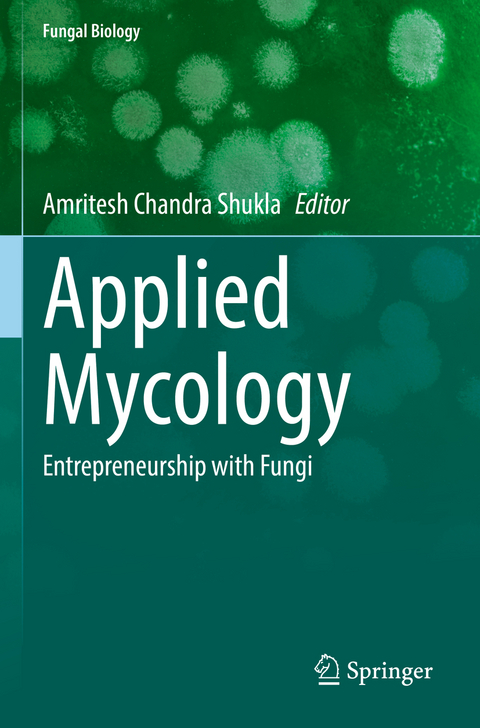
Applied Mycology
Springer International Publishing (Verlag)
978-3-030-90651-1 (ISBN)
In the food and drink arena, the role of fungi is historically important in the form of mushrooms and in fermented foods as yeasts for baking and brewing. These roles are supplemented by the use of fungal food processing enzymes and additives, and more recently in the development of protein-based foodstuffs from fungi. Additionally, they are used in the formulation of biofertilizers and biopesticides used as biostimulants and bioprotectants of crops. The practical use of newer techniques such as genetic recombination and robotics have revolutionized the modem agricultural biotechnology industry, and have created an enormous range of possible further applications of fungal products.
Myco-materials created from mycelia (the root-like parts of fungi) are gaining attention as a sustainable alternative for a wide range of materials. They are being used as insulation, sustainable packaging, foam inserts, and even "eco-leather." In fact, mycelium bricks are pound-for-pound stronger than concrete. In addition, medicinal uses of fungal species have been historically recorded as important agents in the pharmaceutical sciences. The potential for myco-materials seems limitless.
The field of mycology and its application has become an increasingly important component in the education of industrial biotechnology. This book on applied mycology provides information helpful for developing entrepreneurial opportunities with fungi. This volume explains both the basic science and the applications of mycology and bio-resource technology with special emphasis on entrepreneurial applications. It offers a complete, one-stop resource for those interested in microbiology, food and agricultural science, medical mycology, and for those in industrial biotechnology.
Amritesh Chandra SHUKLA is Professor of Botany at University of Lucknow, India. His research has mainly focused on exploration and conservation of fungal diversity and its bioprospection as well as unraveling the mechanism of action of potential antifungal plant products/ biomolecules as pharmaceuticals and herbal drugs. He has developed some commercial antifungal formulations and granted USA, UK, Japanese and Indian patents. He has credited eleven books, and published his research findings in various internationally reputed journals including seminars in cancer biology. For his scientific accomplishments, he received numerous awards and recognition, including the prestigious Fellow of the Linnean Society of London in the year 2021. He has also served the international scientific community well as Visiting Professor- University of Mauritius; and University of British Columbia, Vancouver, Canada. He has been in the expert panel of the Department of Botany and Microbiology, College of Science, King Saud University, Saudi Arabia; and in the Research Degrees and Scholarships Committee, Murdoch University, Perth, Australia.
Preface.- Marine Microbial Enzymes and Their Applications.- Mycoparasitism.- Yeast in Entrepreneurship.- The Edible and Medicinal Fungi.- Mushrooms in Enzyme Production.- Fungal Proteins with Biotechnology Potential.- Microbased Biorefinery for Gold Nanoparticle Production.- Mushrooms as Potential Sources of Entrepreneurships.- Lignocellulosic Biomass and Conversion into Biofuels.- Trichoderma as Potential Biofungicidal and Plant Growth Promoter.- Myco-Metabolites and Their Applications.- Natural Products of Endophytic Fungi and Their Applications.- Fungi as Sources of Biobased Fiber Materials.- Fungal Consortium for Organic Municipal Solid Waste Composting.- Fungal Applications in Biomass to Biorefineries.- Bioengineering Tools for the Production of Pharmaceuticals.- Fungal Metabolites as Sources of Medicines and Dietary Supplements.- Fungi as a Biocontrol Agent.- Bio-Prospects of Fungal Endophytes.- Value-Added Products of Mushrooms.- Index.
"The volume comprises 20 chapters that touch on an impressive range of actual or potential applications ... . Several chapters describe processes to be followed for exploitation, with often clear graphic representations of the steps. ... the book provides many ideas that could be taken up in student projects or implemented on a local scale, and it will surely open the eyes of many to the wide range of applications involving fungi that both exist and await exploitation." (David L. Hawksworth, The Quarterly Review of Biology, Vol. 98 (4), December, 2023)
“The volume comprises 20 chapters that touch on an impressive range of actual or potential applications … . Several chapters describe processes to be followed for exploitation, with often clear graphic representations of the steps. … the book provides many ideas that could be taken up in student projects or implemented on a local scale, and it will surely open the eyes of many to the wide range of applications involving fungi that both exist and await exploitation.” (David L. Hawksworth, The Quarterly Review of Biology, Vol. 98 (4), December, 2023)
| Erscheinungsdatum | 29.04.2023 |
|---|---|
| Reihe/Serie | Fungal Biology |
| Zusatzinfo | XVIII, 447 p. 85 illus., 61 illus. in color. |
| Verlagsort | Cham |
| Sprache | englisch |
| Maße | 155 x 235 mm |
| Gewicht | 712 g |
| Themenwelt | Naturwissenschaften ► Biologie ► Genetik / Molekularbiologie |
| Naturwissenschaften ► Biologie ► Mikrobiologie / Immunologie | |
| Naturwissenschaften ► Biologie ► Mykologie | |
| Schlagworte | Agricultural Mycology • Entrepreneurship • Food Technology • Industrial Biotechnology • medical mycology • Microbial Biotechnology • Mushroom Technology |
| ISBN-10 | 3-030-90651-5 / 3030906515 |
| ISBN-13 | 978-3-030-90651-1 / 9783030906511 |
| Zustand | Neuware |
| Informationen gemäß Produktsicherheitsverordnung (GPSR) | |
| Haben Sie eine Frage zum Produkt? |
aus dem Bereich


